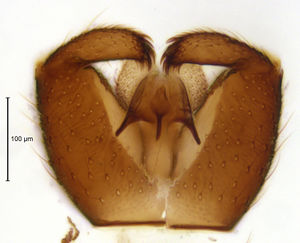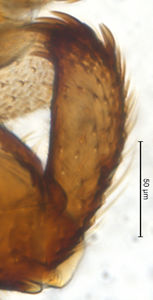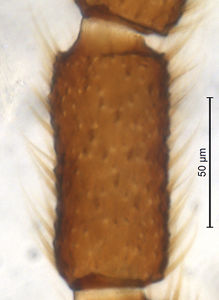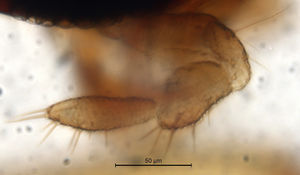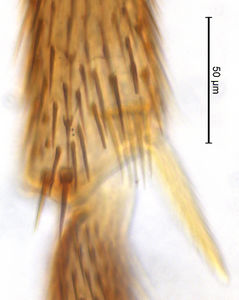Bradysia bellstedti
Ordo: Diptera
Familia: Sciaridae
Genus: Bradysia
Name
Bradysia bellstedti Menzel & Mohrig, 1998 – ZooBank link
- Bradysia bellstedti Menzel & Mohrig, 1998[1]: 359
- Bradysia procera Mohrig & Menzel, 1990[2]: 368-369, fig. 18
Type material
Holotype ♂, 4.7.1988, sweep netting, in PWMP, leg. Bellstedt
Type locality
Germany, Thuringia, near Herbsleben
Barcoded material studied
| Stadium | Country | Province | Locality | Habitat | Method | Date | Collector | Collection Number | Collection | Latitude | Longitude | Elevation (m) |
|---|---|---|---|---|---|---|---|---|---|---|---|---|
| 1 ♂ | Norway | Sogn og Fjordane | Laerdal, Eraksdalen | netted | 04.06.2014 | Heller, K. | bf-sci-00130b | NHMO | 61.058 | 7.963 | 644 | |
| 1 ♂ | Norway | Sogn og Fjordane | Laerdal, Eraksdalen | netted | 04.06.2014 | Heller, K. | bf-sci-00778 | NHMO | 61.058 | 7.963 | 644 |
Description (male)
Head. Eye bridge 3–4 rows of facets. Antenna unicolour. LW-index of 4th flagellomere 1.9–2.1; neck 0.22–0.32 × segment width; transition of basal part to neck pronounced. Colour of neck unicolour. Antennal setae shorter than segment width; of normal strength; dense. Sensillae present. Palpus darkened; of normal length; palpomeres 3. First palpomere of normal shape; with 3–6 setae; with delimited sensillary field. Second palpomere short and oval. Third palpomere as long as first. Thorax. Colour brown. Notum unicolour. Thoracic setae weak; white. Posterior pronotum bare. Mesothoracic sclerites bare. Legs. Colour yellow-brown. Hind coxa of same colour as femora. Setae on front coxa pale. Front tibial organ as distinct, delimited comb; pale; front tibial organ not bordered. Tibial comb undivided. Tibial comb with 5 bristles. Tibial setae on hind legs weak and inconspicuous. Tibial spurs of equal length. Claws untoothed. Wing. Wing slightly darkened; of normal shape. Wing membrane without macrotrichia. Wing venation weak, with faint stM. M-fork of normal shape. R1 ending clearly before base of m-fork; posterior veins bare; bM bare; r-m bare; bM:r-M 0.85–1.05; st-Cu:bM 0.5–0.7; R1:R 0.5–0.6; c:w 0.62–0.72. Halter darkened; of normal length. Abdomen. Abdominal setae weak; sparse; on tergites white; on sternites white. Hypopygium concolour with abdomen; LW-index 0.64–0.74. Base of gonocoxites with weak setae; gonocoxites narrowly separated; inner margin of gonocoxites typically U-shaped; inner membrane of hypopygium bare; ventral margin of gonocoxite with short setae. Gonostylus elongate; LW-index 3.2–3.8; Inner margin straight; apex tapered. Apical tooth dorsally present; without internal structure; strong; shorter than subapical megasetae; LW-Index 4–5. Awl-like setae absent. Megasetae present; number of megasetae 10–13; thick; curved; in one group. Position of basalmost megaseta 15–23 % from top. Whiplash-hair absent. Tegmen equally rounded; without special features; central process absent. Length of ejaculatory apodeme/hypopygium 12–20 %; base of ejaculatory apodeme present. Field with aedeagal teeth clearly visible. Measurements. Body size 1.8–2.3 mm. Hind tibia 0.55–0.65 mm. Wing length 1.6–2 mm.
Diagnosis
Bradysia bellstedti is distinguished by other species of the Bradysia nitidicollis complex by the large and equally rounded tegmen, which is otherwise typical for the Bradysia fungicola group. The gonostylus however, with numerous and strong apical spines in combination with a strong dorsal tooth is characteristic for the nitidicollis-like species. In particular the shape of the gonostylus closely resembles Bradysia quercina.
DNA Barcoding
The COI sequence is assigned to BIN BOLD:ACY9209 (average distance 0.00%, max. 0.00%, n=2, K2P: 9.64%).
Discussion
Bradysia bellstedti is apparently a rarely encountered species. A replacment name of Bradysia procera was necessary due to the secondary homonymy with Bradysia procera (Winnertz, 1867), originally described as Sciara procera. The latter species is currently placed in a different species group of Bradysia, the procera group. A possible rearrangement of the mega-genus Bradysia may result in a splitting into different separate genera. This might set aside the secondary homonymy and lead to the re-establishment of the older species group name procera instead of bellstedti
DNA-barcoding assigned the unique BIN BOLD:ACY9209 to the Norwegian specimens with the nearest neighbour being Bradysia parvifinis. Both species are genetically allied to Bradysia nitidicollis.
Etymology
The species was named after its collector, Ronald Bellstedt
Distribution
Germany[2], Netherlands[3], Norway.
Images
|
References
- ↑ Menzel, F.; Mohrig, W. 1998: Beiträge zur Taxonomie und Faunistik der paläarktischen Trauermücken (Diptera, Sciaridae). Teil VI - Neue Ergebnisse aus Typenuntersuchungen und die daraus resultierenden taxonomisch-nomenklatorischen Konsequenzen. Studia dipterologica, 5, 351–378.
- ↑ 2.0 2.1 Menzel, F.; Mohrig, W.; Groth, I. 1990: Beiträge zur Insektenfauna der DDR: Diptera - Sciaridae. Beiträge zur Entomologie, 40, 301-400.
- ↑ Mohrig, W. 1996: Sciaridae (Rowmuggen). In: J. W. A. van Zuijlen, T. M. J. Peeters, P. S. van Wielink, A. P. W. van Eck, et al. (Eds.), Brand-Stof. Een inventarisatie van der entomofauna van het Natuurreservaat “De Brand” in 1990. Insektenwerkgroep KNNV-afdeling, Tilburg. pp. 97–98.

